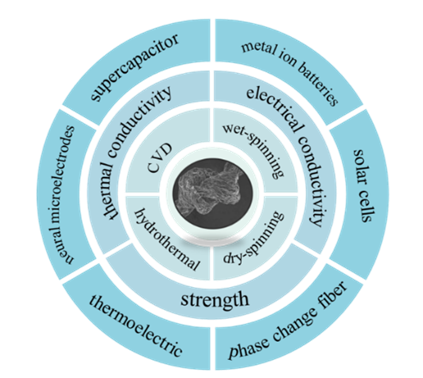H.Q. Liu†, F. Zhou†, X.Y. Shi, Q. Shi*, Z.-S. Wu*
Acta Physico-Chimica Sinica,2022, 38, 2204017-0.
DOI: 10.3866/PKU.WHXB202204017 [PDF]

With the rapid advancement of intelligent microelectronics and the “Internet of Things” sensing microsystems with miniaturized and wearable properties, the development of novel fiber-based functional materials for application in flexible and microscale electrochemical energy storage devices has become an important strategic direction. However, this imparts higher requirements on the properties of fiber functional materials for use in flexible energy storage devices, including high bendability, stretchability, foldability, high strength, excellent interfacial stability, and high energy storage density. Based on its unique structure, excellent conductivity, and favorable mechanical and electrochemical properties, graphene-based fibers are expected to be a novel flexible functional material with high performance. To date, various strategies have been developed to control the microstructure to achieve further improvements in graphene fibers, from preparation methods to fundamental properties. In this review, a systematic summary of the recent advances in the preparation methods of graphene-based fibers is presented, including the limited hydrothermal synthesis, chemical vapor deposition (CVD), dry spinning, and wet spinning methods, and each method is discussed in terms of its advantages and disadvantages. Subsequently, strategies to improve the mechanical strength, electrical conductivity, and thermal conductivity of graphene fibers are highlighted, including the regulation of basic materials, improvement of the preparation process, and controlling subsequent processing. Recent research on the application of graphene fiber in energy storage and conversion is also summarized. Based on the exceptional electrical conductivity and pore structure of graphene fibers, it has significant application prospects in the field of electrochemical energy storage devices, such as supercapacitors, metal-ion batteries, and solar cells. Moreover, graphene fibers have a wide range of applications in phase change fibers and thermoelectric generators owing to their excellent thermal conductivity. This review summarizes and discusses the preparation of the basic constituent units of graphene fibers, development of novel graphene fibers, interfaces between graphene fibers and active materials, packaging strategies and safety issues of graphene fiber-based electrochemical energy storage devices, andcurrent evaluation criteria for graphene fiber performance. Finally, the ongoing challenges and future prospects of graphene fibers for advanced energy conversion and storage systems are presented.